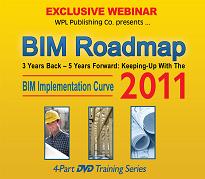Proven Benefits, Increased Demand, Is Reality Exceeding Promise?
In our first BIM Roadmap series (2008), we took a first look at where the construction industry stood in understanding what Building Information Modeling (BIM) was, where it was going and how owners and contractors should get started. Indeed, back then we got many emails asking what "B-I-M" stood for when we failed to spell it out in one of our promotions! Since then, BIM has clearly come a long way.
The A/E community is on the downhill slope of transition from 2D computer-aided drafting (CAD) to drawing directly in 3D BIM software. Most federal agencies have BIM initiatives and many non-federal public organizations are adding their own requirements. On large complex projects, BIM use is becoming a no-brainer for its ability to coordinate trades and eliminate design conflicts. Forward-thinking owners AND contractors understand that BIM saves them time and money, and no longer is the question asked who should pay the extra costs of BIM. It's not a question of cost anymore, it's a question of real productivity gains.
In our 4th annual BIM Roadmap series, we call upon industry experts to relate their experiences, and tell you how and why you should move on to the next step in your own quest to become BIM-fluent. You cannot afford to NOT implement BIM. Today, it's a clear competitive advantage. Tomorrow, it will be second nature and expected to be implemented. Your projects will enjoy more on-time completion with less change orders, less claims and less stress, ready to focus on the next project coming down the line.
BIM Roadmap 2011 Webinar Series:
Session 1
Productivity Benefits of BIM: How Private Owners are Driving the Industry
This 90-minute recording will review the BIM basics and what are the expected benefits. It will provide you sources of further education to prepare you for doing business in a significantly changed future. John Moebes will outline the initiatives that Crate&Barrel has instituted to improve project delivery through the use of BIM. He will focus on three sectors: the Design Consultants, the Contractors, and the Owners and how they can make important changes that can improve project delivery.
- The most common benefits of BIM: improved code compliance checking, better life safety and energy efficiency design, reduced approval cycles, increased pre-fabrication, less crowded and safer worksites, reduced waste and reduced change orders.
- Recent progress in standards and cooperation to facilitate increased BIM usage.
- How BIM changes the workflow and management processes.
- Benefits to owners: an improved product and enhanced facilities management.
- AND MUCH, MUCH MORE!
Session 2
Update on Federal and Public BIM Initiatives
Public owners have been leading by example in innovation, as illustrated by 7 years of Award Winning BIM at GSA and elsewhere. Learn the highlights of GSA's successes, how benefits are exceeding expectations and about the upcoming BIM Guide 08 will affect the requirement for contractor submissions and close the BIM loop to tie-in Facilities Management.
This session also provides insight into the BIM implementation strategy adopted by the Department of Administration that led to the BIM Guidelines and Standards that became effective July 1, 2009. The process that was followed and the development of the next implementation stage will also be presented. Topics covered in this session include:
- Overview of Wisconsin BIM Implementation Strategy
- Content of Wisconsin BIM Guidelines and Standards
- Facility Management Handover Guidelines
- BIM in relationship to design professionals and construction industry
- Related digital technologies
- Challenges
Session 3
Contractor BIM Implementation: Experienced Contractors Discuss Critical Success Factors and Best Practices
Learn the challenges facing contractors and construction managers, and the productivity benefits they reap from their BIM implementations: how to deal with shared or separate models; laser scanning, clash detection and spatial coordination; coordination of trades, and an Introduction to 4D-Scheduling, 5D-Estimating and more.
Session 4
Integrated Project Delivery (IPD) and Other Delivery Methods:
Tailoring BIM to the Delivery Method; Or Vice Versa
Delivery methods and BIM - how best to implement BIM using various delivery methods, and what to expect its impact to be on the project with each. Mini-case studies will be presented to illustrate why Integrated Project Delivery is so promising.

